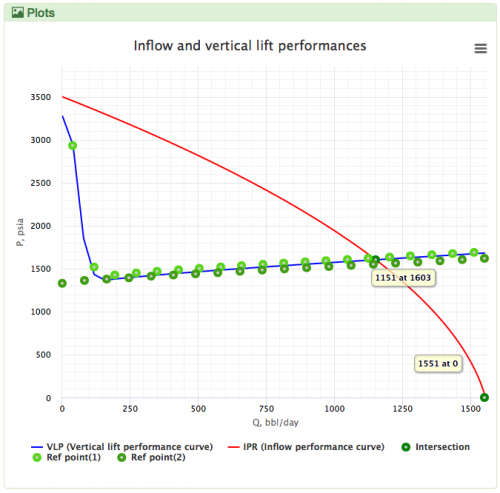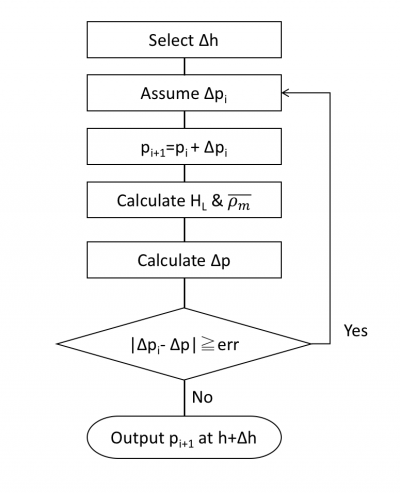Beggs and Brill correlation
Contents
Brief
Beggs and Brill is an empirical two-phase flow correlation published in 1972 [1].
It does distinguish between the flow regimes.
Beggs and Brill is the default VLP correlation for the oil in the sPipe.
Math & Physics
Following the law of conservation of energy the basic steady state flow equation is:
where
Colebrook–White [3] equation for the Darcy's friction factor:
Reynolds two phase number:
Discussion
Why Hagedorn and Brown?
One of the consistently best correlations ...— Michael Economides et al[5]
Flow Diagram
Workflow HL
Modifications
1. Use the no-slip holdup when the original empirical correlation predicts a liquid holdup HL less than the no-slip holdup [5].
2. Use the Griffith correlation to define the bubble flow regime[5] and calculate HL.
3. Use watercut instead of WOR to account for the watercut = 100%.
Nomenclature
 = flow area, ft2
= flow area, ft2 = correlation group, dimensionless
= correlation group, dimensionless = formation factor, bbl/stb
= formation factor, bbl/stb = coefficient for liquid viscosity number, dimensionless
= coefficient for liquid viscosity number, dimensionless = pipe diameter, ft
= pipe diameter, ft = depth, ft
= depth, ft = correlation group, dimensionless
= correlation group, dimensionless = liquid holdup factor, dimensionless
= liquid holdup factor, dimensionless = friction factor, dimensionless
= friction factor, dimensionless = gas-liquid ratio, scf/bbl
= gas-liquid ratio, scf/bbl = total mass of oil, water and gas associated with 1 bbl of liquid flowing into and out of the flow string, lbm/bbl
= total mass of oil, water and gas associated with 1 bbl of liquid flowing into and out of the flow string, lbm/bbl = pipe diameter number, dimensionless
= pipe diameter number, dimensionless = gas velocity number, dimensionless
= gas velocity number, dimensionless = liquid viscosity number, dimensionless
= liquid viscosity number, dimensionless = liquid velocity number, dimensionless
= liquid velocity number, dimensionless = pressure, psia
= pressure, psia = conversion constant equal to 32.174049, lbmft / lbfsec2
= conversion constant equal to 32.174049, lbmft / lbfsec2 = total liquid production rate, bbl/d
= total liquid production rate, bbl/d = Reynolds number, dimensionless
= Reynolds number, dimensionless = solution gas-oil ratio, scf/stb
= solution gas-oil ratio, scf/stb = specific gravity, dimensionless
= specific gravity, dimensionless = temperature, °R or °K, follow the subscript
= temperature, °R or °K, follow the subscript = velocity, ft/sec
= velocity, ft/sec = water-oil ratio, bbl/bbl
= water-oil ratio, bbl/bbl = gas compressibility factor, dimensionless
= gas compressibility factor, dimensionless
Greek symbols
 = absolute roughness, ft
= absolute roughness, ft = viscosity, cp
= viscosity, cp = density, lbm/ft3
= density, lbm/ft3 = integrated average density at flowing conditions, lbm/ft2
= integrated average density at flowing conditions, lbm/ft2 = surface tension of liquid-air interface, dynes/cm (ref. values: 72 - water, 35 - oil)
= surface tension of liquid-air interface, dynes/cm (ref. values: 72 - water, 35 - oil) = secondary correlation factor, dimensionless
= secondary correlation factor, dimensionless
Subscripts
g = gas
K = °K
L = liquid
m = gas/liquid mixture
o = oil
R = °R
SL = superficial liquid
SG = superficial gas
w = water
References
- ↑ Cite error: Invalid
<ref>tag; no text was provided for refs namedBB - ↑ 2.0 2.1 2.2 2.3 2.4 2.5 2.6 2.7 2.8 Hagedorn, A. R.; Brown, K. E. (1965). "Experimental study of pressure gradients occurring during continuous two-phase flow in small-diameter vertical conduits". Journal of Petroleum Technology. 17(04): 475–484.
- ↑ Colebrook, C. F. (1938–1939). "Turbulent Flow in Pipes, With Particular Reference to the Transition Region Between the Smooth and Rough Pipe Laws"
 . Journal of the Institution of Civil Engineers. London, England. 11: 133–156.
. Journal of the Institution of Civil Engineers. London, England. 11: 133–156.
- ↑ Moody, L. F. (1944). "Friction factors for pipe flow"
 . Transactions of the ASME. 66 (8): 671–684.
. Transactions of the ASME. 66 (8): 671–684.
- ↑ 5.0 5.1 5.2 5.3 5.4 5.5 Economides, M.J.; Hill, A.D.; Economides, C.E.; Zhu, D. (2013). Petroleum Production Systems (2 ed.). Westford, Massachusetts: Prentice Hall. ISBN 978-0-13-703158-0.
- ↑ 6.0 6.1 6.2 6.3 6.4 6.5 Lyons, W.C. (1996). Standard handbook of petroleum and natural gas engineering. 2. Houston, TX: Gulf Professional Publishing. ISBN 0-88415-643-5.
- ↑ 7.0 7.1 Trina, S. (2010). An integrated horizontal and vertical flow simulation with application to wax precipitation (Master of Engineering Thesis). Canada: Memorial University of Newfoundland.











![N_L = 0.15726\ \mu_L \sqrt[4]{\frac{1}{\rho_L \sigma_L^3}}](/images/math/b/2/0/b207fe79b4a4ee53d466e182791ca737.png)



![N_{LV} = 1.938\ v_{SL}\ \sqrt[4]{\frac{\rho_L}{\sigma_L}}](/images/math/d/d/8/dd824df0b6ec22aa724161b929e993fe.png)
![N_{GV} = 1.938\ v_{SG}\ \sqrt[4]{\frac{\rho_L}{\sigma_L}}](/images/math/3/6/4/364153c39c1657b3b7bab8f7ed710e60.png)






